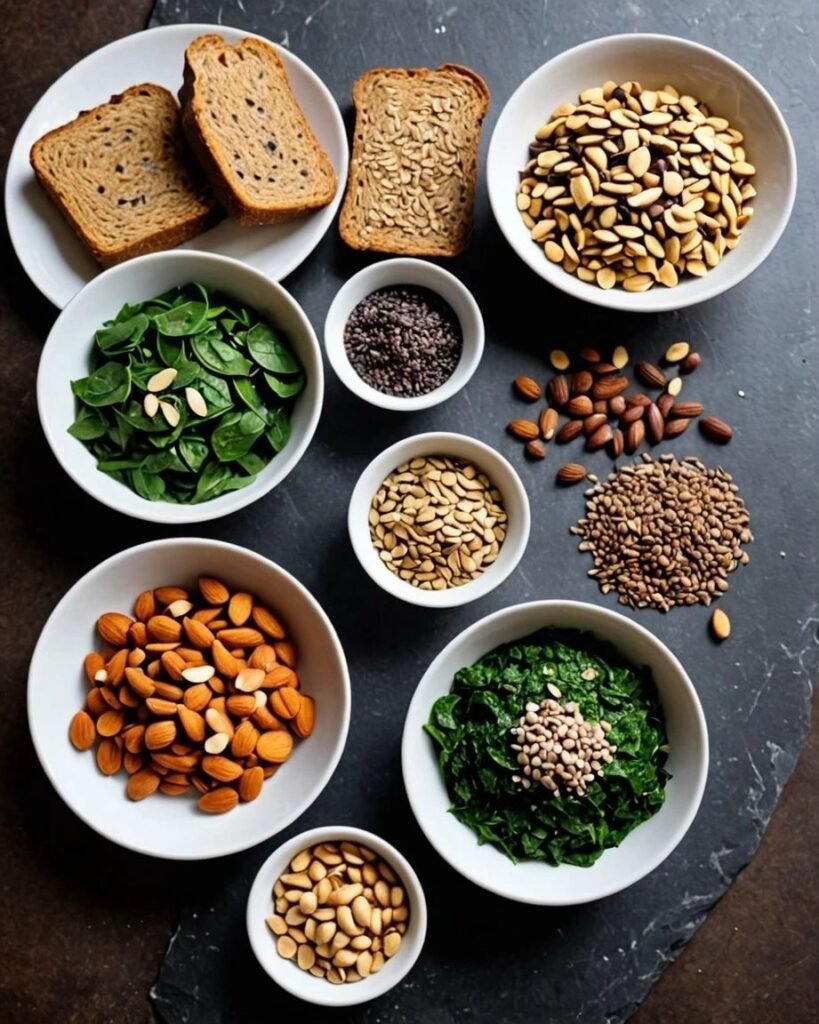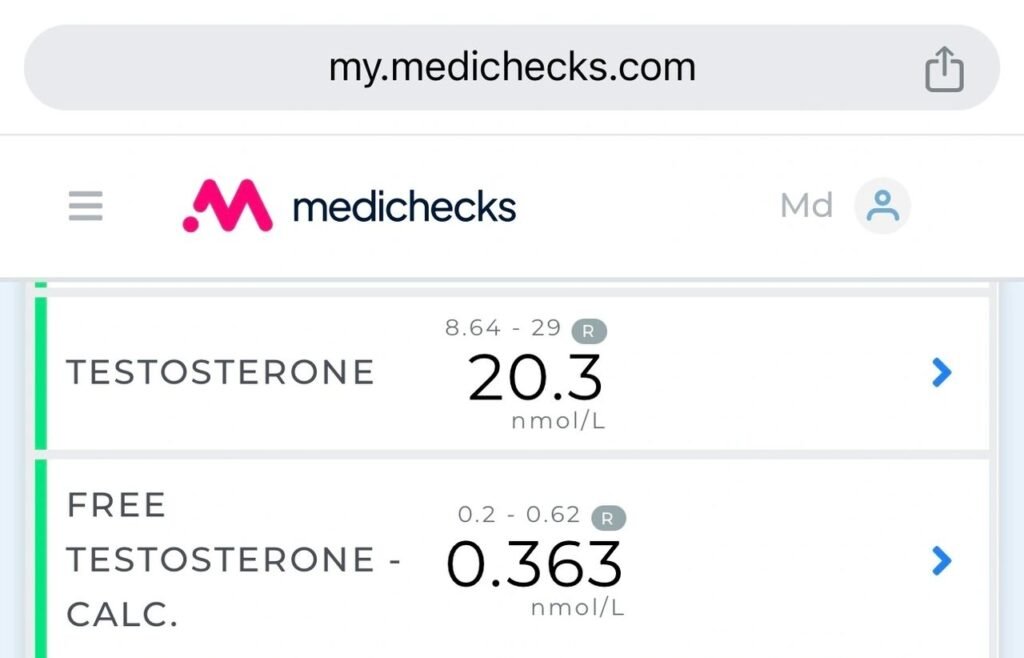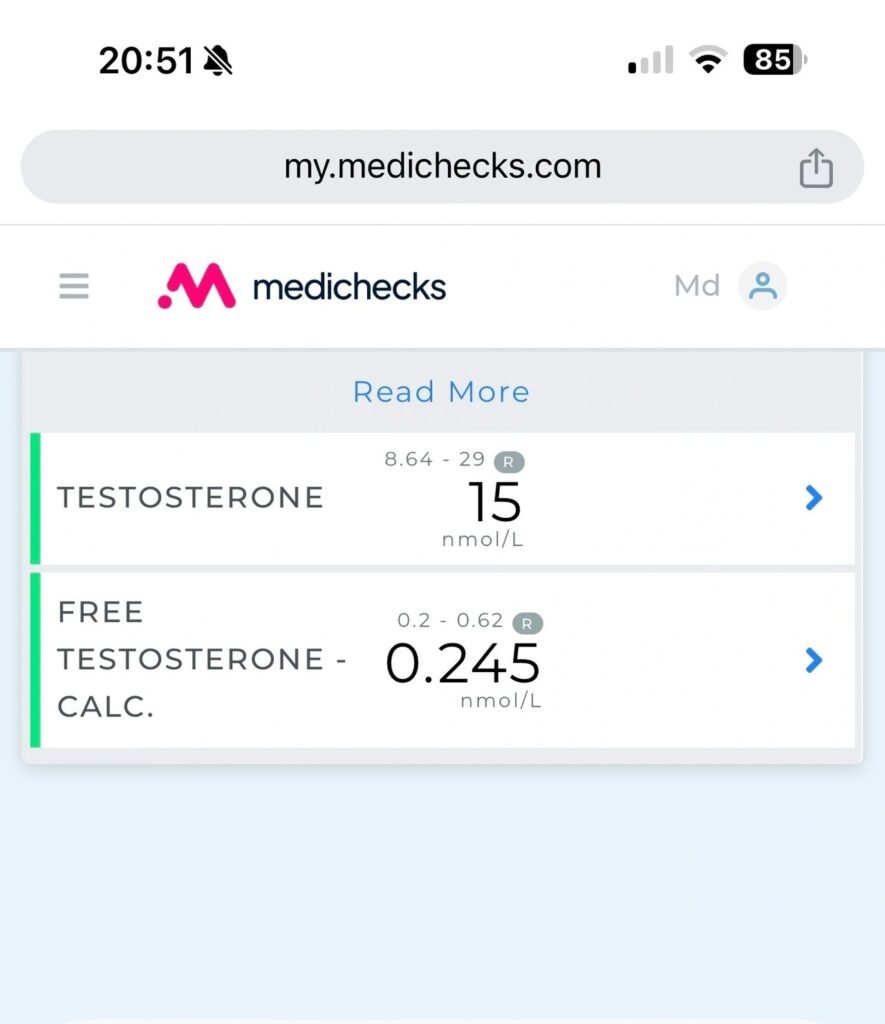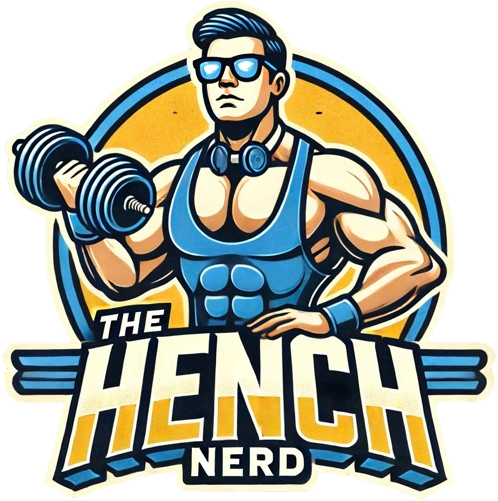How can you raise testosterone naturally? By reading on…
This is another long article, and it needed to be. I aim to provide the maximum value in exchange for your time. If you do enjoy my posts, I’d be extremely grateful for an email subscription to my site. You can locate the subscription section at the bottom of my homepage. You’ll be notified the instant new articles are released.
This article will thoroughly cover how can you raise testosterone naturally, along with boosting T levels, improving hormonal health, and fixing low testosterone. You’ll find my personal results near the article’s conclusion.
Disclaimer
As with part 1 covering low testosterone levels, I’m not a doctor. I’m someone who’s extensively researched this subject and is passionate about sharing what I’ve learned with you. Your doctor should always be your first consultation.
Key Takeaways
- Natural methods can raise testosterone: Diet, exercise, sleep, and stress management are fundamental for boosting testosterone levels naturally without the need for TRT.
- Body fat affects testosterone: Maintaining an ideal body fat percentage (12-17%) is crucial for optimal testosterone production, as excess body fat converts testosterone into estrogen.
- Exercise is essential: Strength training and HIIT workouts have been shown to significantly boost testosterone levels, while overtraining can lower them.
- Micronutrients matter: Adequate intake of vitamins and minerals like zinc and boron is important for testosterone optimisation. Supplements may help but are not a substitute for lifestyle changes.
- TRT is a life-long commitment: If natural methods fail to increase testosterone levels, TRT may be considered, but it comes with risks such as infertility, cost, and health side effects.
- Endocrine disruptors reduce testosterone: Avoid exposure to chemicals in plastics, certain personal care products, and non-stick cookware to minimise hormone disruption.
A Natural Testosterone Fix
At the conclusion of part 1, I disclosed my own testosterone results, which scored 433 (15) overall levels and free testosterone at 0.245. The results were within the normal testosterone range, albeit free testosterone was slightly low (remember, from part 1, this is the bioavailable testosterone level, often considered the golden number), and I was experiencing some low testosterone symptoms.
Thanks to some great advice from a non-profit TRT clinic doctor, I decided to utilise my knowledge and attempt to raise my testosterone naturally.
I wanted to explore if the symptoms I was experiencing might be fixed by paying better attention to some key aspects of health. The alternative would be lifelong testosterone therapy (more on that later). At the time, I was 40 and unwilling to potentially take the premature plunge unless absolutely necessary.
If you’re in the same position as me or testing lower, I’d remind you of my part 1 comment,
“Often low testosterone is a symptom of a lifestyle choice/deficiency and easily treatable. It is certainly possible to optimise prior to going down a potentially costly and forever route.”
The link between body fat and testosterone
There is a huge link between body fat and testosterone. Part 1 touched upon being overweight (and carrying too little body fat) and its correlation with low testosterone. Why is this? For a few reasons:
Fat tissue
Fat tissue contains an enzyme called aromatase. This directly converts testosterone to estrogen, thus lowering testosterone levels and causing low T symptoms.
Hormonal imbalance
Excess body fat wreaks havoc on hormones and can create an imbalance. Increased leptin (a hormone produced by fat cells) has been directly linked to lower testosterone levels.
Insulin resistance and inflammation
This occurs from being overweight. It can impact the pituitary gland and hypothalamus (you’ve learned about these in part 1, which are crucial for creating testosterone).
Testicular effects
These can occur with increased fat deposits in and around the testes, which can disrupt normal testicular function.
The Body Prefers Balance
As I’ve stated countless times, the body doesn’t like to be at critically low levels of body fat or at the higher end of the spectrum. It unsurprisingly prefers a normal range to work with. You’ll also recall in part 1, I stated testosterone levels have been reducing throughout the decades. Increasing waistlines isn’t the sole reason, but a huge factor towards low testosterone and associated symptoms.
If you’re not between 12-17% body fat, I’d strongly recommend you get there (I have many articles on fat loss within the blog). It’s one of (if not the) most pertinent actions you can take to successfully raise your testosterone levels naturally.
Getting between 12-17% body fat is critical for how you can raise testosterone naturally and fixing low testosterone symptoms. You’ll get nowhere fast unless you grasp this point and take action.
“Studies show that body fat is inversely associated with testosterone levels, meaning that as body fat increases, testosterone levels tend to decrease. This is due to the enzyme aromatase found in fat tissue, which converts testosterone into estrogen.” (Source: Journal of Clinical Endocrinology & Metabolism)
The Saturated Fat Lie
Remember the low-fat diet craze that started in the 70s and 80s and continues to this day? This is a fantastic way to lower testosterone levels. I will someday write a post covering this in more depth, as I’ve nothing but contempt for this false advice.
You must grasp that nutrition is a relatively early science, and people aren’t infallible. If 999 people are echoing one statement and 1 person an opposing but truthful statement, it doesn’t mean 999 people are correct.
An American physiologist called Ancel Keys completed a seven countries study in 1958. He linked saturated fat with heart disease, and the rest is history. As mentioned, I will write a whole article on this controversy. The study was grossly flawed. Unfortunately, it was adopted by the world and its various health organisations.

Do you recall in part 1 when I stipulated testosterone is created from cholesterol? Guess where cholesterol comes from? You guessed right, saturated fat.
Now before you go chewing on a block of butter and drinking a gallon of beef tallow, hear me out. There’s a world of difference between knowing saturated fat is perfectly healthy and should be eaten in moderation, as opposed to overindulging. As with most things in life, there’s a point of diminishing returns, and more isn’t always better. Water in excessive amounts will kill you.
The Cholesterol Lie
You’ll no doubt come back at me with, “Matt, doesn’t saturated fat raise cholesterol levels?” You’d be countered with a question, “Why is that necessarily a bad thing?”. You see, in parallel to saturated fat, cholesterol has also been vilified, unnecessarily so. Once again, I could (and probably will) write an entire article on cholesterol (a hugely complex subject), or you’d be reading this section all night.
Cholesterol is a fix-it steroid. It’s the body’s natural healing substance. It comes to the rescue when there is an injury present anywhere within the body. Blaming cholesterol for heart disease is based upon it showing up within inflamed arteries. It’s the equivalent of holding firemen accountable for starting a fire, only because they were present at the scene.
This is the exact reason why cholesterol has been vilified over the years. In addition to this, the body can create cholesterol without dietary fat.

There is one type of fat with a resounding unhealthy label attached to it: trans (or hydrogenated) fats. At the time of writing, some countries have banned these harmful fats, while others (like my own, the UK) have accepted reduction promises from manufacturers.
The saturated fat lie will take decades for us to recover from, if ever. Men have veered well away from eating foods that naturally promote healthy testosterone levels.
Sugar Lowers Testosterone
Excess sugar seems to be the real culprit for a host of health issues outside of this article’s purpose. Again, for another day.
Putting it as bluntly as I can, maintaining a low-fat and high-carb diet will do nothing towards naturally raising T levels and fixing low testosterone symptoms.
Some quick bullets on why sugar is so bad for testosterone levels (T):
- Poor sleep
Especially if consumed near bedtime. Lack of sleep will severely impact testosterone levels. - Oxidative stress
Excess sugar can increase oxidative stress within the body. This can damage the testes and impair testosterone production. - Insulin spikes
Constant insulin spikes can affect the Leydig cells within the body. These cells are directly responsible for producing testosterone. - Chronic inflammation
High sugar intake can cause chronic inflammation, which in turn impacts the endocrine system, leading to reduced testosterone. - Fatty liver disease
Excessive consumption can impact the liver and cause fatty liver disease. A compromised liver will wreak havoc on the body, including reduced testosterone levels. - Raised cortisol levels
Cortisol is your stress hormone, and excess sugar negatively impacts cortisol levels, unsurprisingly causing lowered testosterone. - Insulin resistance
Insulin resistance can be a result of high sugar intake (your pancreas doesn’t work like it should) and is a major disruptor of hormone levels.
Don’t Blame the Fat For What Sugar Did
The above section might make it seem like I identify as a ketogenic diet zealot. I’m certainly not. I do lean towards lower carb for most completely sedentary people.
How can you raise testosterone naturally? One thing is clear: sugar reduces testosterone. Reduce your consumption for higher testosterone levels. Bear in mind, I still ate a small chocolate bar every night during my 3-month optimisation experiment. Lower your sugar intake and raise your fat intake for better results.

How Can You Raise Testosterone Naturally With Diet?
We know meal frequency is irrelevant. Whether you choose to eat once or four times a day, It’s irrelevant for weight loss, and the same is true of testosterone levels. Understanding what foods raise testosterone levels is crucial.
If you’re over 17% body fat, you must diet down to 17% (15 or slightly lower is ideal, under 10-12 and you’ll potentially be suffering from low testosterone due to insufficient body fat—see part 1). As referenced above, this is one of the most critical actions you must undertake to give yourself the best chance of naturally raising T levels and fixing low testosterone symptoms.
When you’re at an ideal body fat percentage, you must ensure you’re eating at maintenance calories. A calorie deficit will negatively impact testosterone (once excess body fat is lost). A good rule of thumb—if you’re active, which you should be to keep testosterone in mind—is to eat at your bodyweight in lbs x 15 or 16. This will be your daily calorie allowance.
I’m deliberately keeping this section less specific and more focused on theory/ground rules to follow. I don’t want to put a strict diet in place for you, as you’ll adhere to your own meal frequency and food preferences. My fat loss link above should assist with more detailed information if needed.
As always, I do recommend MyFitnessPal. What gets measured gets done.
Let’s take me as an example to calculate calories and protein. I’m 175 lbs and very active. 175 x 16 = 2800 calories per day allowance.
How Can You Raise testosterone Naturally Diet Tips
Protein and carbs contain 4 calories per gram, while fat contains 9 calories per gram.
Prioritise protein
Protein should be prioritised and is so important to health. I eat 1 gram of protein per lb of bodyweight. That’s 175 grams per day for me. My fat loss article linked above covers protein in more depth and the foods highest in protein.
Evenly split fat and carbs
Split your fat and carbs fairly equally (not necessarily at every meal, but as an average throughout the day). Achieving pinpoint accuracy with your fat/carbs split doesn’t matter (stay within total calories), so don’t obsess over it. By splitting your macronutrients this way, you won’t be eating excess sugar/carbs and you’ll be consuming plenty of fat. You’ll also have room for treats.
If you’re less active, I’d allow for a higher fat and lower carb ratio. How can you raise testosterone naturally? Don’t go too far out of whack with your carb and fat split.
Some good carb sources to stick to (no surprises here—good wholesome carbs):
- Fruit
- Vegetables
- Potatoes
- Rice
- Oats
- Bread/pasta (if you can handle them. I generally feel better off grains)
- Beans
Enjoy carbs, just shift the balance towards an equal amount of fat in your diet.
Good fat choices for raising testosterone (monounsaturated fats included too, these are great):
- Butter
- Lard
- Avocados
- Coconut oil
- Fatty red meat
- Eggs (yes, the yolk)—I eat around 4 most days
- Olives/Olive oil
- Full-fat Greek yogurt
- Nuts
- Oily fish
- Cheese
Remember
- Calculate calorie and protein intake
- Split carbs and fats evenly
- Make common sense dietary choices
Plenty of fruit and veggies, and less processed sugary junk. Don’t fear fat, and shift the balance towards more fat than what is recommended by the mainstream.
I enjoyed a 250-calorie chocolate bar every evening as my treat allowance for the day.
It’s okay if you mess up one day. Stay generally consistent with your actions and you’ll be fine. You can certainly increase testosterone with diet.
More on sleep below, but try and eat your last meal by 6 pm. Your sleep quality will be greatly improved. The same goes for ensuring your water intake is capped around 2 hours before bed.
I haven’t covered alcohol. As you’d suspect, alcohol reduces testosterone. If you must drink, keep it to a couple of drinks over the weekend. If you want optimal hormone levels, you won’t get there by feeding your body poison.
Diet is a huge topic to cover off and this blog has it’s own diet and fat loss section.
Micronutrients for testosterone
How can you raise testosterone naturally? Learn all about micronutrients.
These aren’t only essential for optimal health, but adequate micronutrients for testosterone optimisation is vital. We commonly know micronutrients as vitamins and minerals.
Due to today’s junk food culture, and the quality of our food and soil being less mineral-rich than years ago, it’s rather easy to suffer from a micronutrient deficiency. This is bad news, as some are vital for healthy testosterone.
The Micro’s You Need To Care About
Listed below are the most common micronutrient deficiencies (relating to testosterone), the recommended daily allowance (RDA), and where you can obtain them from.
Zinc
RDA: 11 mg per day. Abundant in pork, lamb, shellfish, legumes, seeds, nuts, dairy products, wholegrain, and eggs.

Vitamin D
RDA 600 IU per day. Vitamin D is hugely important for general health. We get it in abundance by being in sunlight. Other sources include fatty fish, egg yolks and liver. It’s Also fortified in milk, organge juice and cereal.

Magnesium
A huge deficiency suffered by a large % of the world. RDA is 400mg per day. Sources include nuts (mainly almonds and cashews), seeds (pumpkin and chia), leafy green vegetables, wholegrain, legumes and dark chocolate

Vitamin B6
RDA is 1.5 mg per day. Found in fish, poultry, potatoes, bananas, chickpeas, many non citrus fruits

Vitamin B12
RDA 2.4mcg per day. Present in all meat, eggs, dairy products and fortified cereals

Selenium
55mcg per day. Sources are Brazil nuts, seafood, meat, eggs and wholegrain products.

A good multivitamin/mineral supplement will act as a subpar insurance policy. There’s always the issue of absorption, and cramming so many ingredients into a pill could result in some counteracting others (nature doesn’t work like this). Ensure you attempt to gain the majority of the above from your food and use a multivitamin as exactly advised, a poor insurance policy.
I’m going to add another trace mineral into the mix—Boron. Research is showing that Boron is proving useful in increasing free testosterone levels. It’s inexpensive, and you should supplement with Boron at a 6 mg per day dosage.
How can you raise testosterone naturally with exercise?
This section will be briefer than you’d anticipate. In a similar vein to the diet section, searching for the perfect workout can lead to paralysis via analysis. I’ve quoted the phrase, “Perfect is the enemy of good” several times on my blog posts, and it’s so true.
Strength train 3-4 days a week
Train with as much intensity as your health and experience allow. Strength training will be a critical weapon in naturally raising T levels and fixing low testosterone symptoms.
Keep your workouts to no more than an hour to keep testosterone-zapping cortisol at bay.
Perform HIIT workouts once or twice a week
HIIT training can boost testosterone to a greater degree compared to steady-state, lower-intensity cardio. You can pick any cardio machine or use your body and alternate short, maximum all-out bursts of energy (30 seconds – 1 minute depending on fitness levels), followed by a low-intensity/rest period of a minute.
No need to go beyond 20 minutes, as intensity is paramount. You can slot this in following strength training (I’d keep the strength training closer to 45 minutes if you do so) or incorporate it on your non-lifting days. If you already participate in intense sports, this will be adequate.
“High-Intensity Interval Training (HIIT) has been shown to increase testosterone levels more effectively than steady-state endurance exercise.” (Source: European Journal of Applied Physiology)
Ensure adequate rest
Aim for 2 full days a week away from intense exercise. Rest and recuperation do wonders for testosterone. Overtraining lowers testosterone levels. If you’re overworking your body, it’s not going to keep testosterone levels optimal, in addition to your immune system being compromised. Work hard and ensure adequate rest!
Keep your steps and general movement up
Being sedentary can lower testosterone levels. Ensure you’re getting out in nature for that precious vitamin D and enjoying low-intensity walking. Aim for 7,500 steps plus per day. You can check out my ultimate fitness article for tips on general fitness.
How can You Raise Testosterone Naturally Through Sleep?
I’ll be honest, I’ve never been a great sleeper. I did make a conscious effort to follow the below advice. I slept better, but still had my moments.
You’ve learned that cortisol lowers testosterone. Stress produces cortisol, and lack of sleep (as you can imagine) wreaks havoc on your cortisol levels.
Good sleep is vital, not only for the testosterone mental benefits, but muscle building, and hormone levels, but for good health in general. You must aim for 7-8 hours per night.
Six tips for a great night’s sleep
- No eating or drinking 3 hours before bedtime. Your body won’t sleep as deeply when it’s processing food. Keeping your fluids lower in the evening will result in fewer sleep-disturbed visits to the bathroom.
- Keeping your room cooler (18 degrees Celsius/65 degrees Fahrenheit) has been proven to help you fall asleep faster and experience deeper sleep.
- Keep your room dark and mitigate noise.
- Retire your phone an hour before bedtime. If you can’t, ensure that you’ve activated a blue light blocker. These days, most phones are equipped with this feature, and blue light signals the body to wake up.
- Write down everything causing you stress in your life and place the notepad downstairs, knowing you’ll tackle them in the morning. This psychological trick works wonders for me.
- Keep your caffeine intake to 2-3 cups a day maximum. Cease all caffeine after 12 pm. I used to be a huge coffee drinker, and my sleep would chronically suffer. This made a huge difference to my sleep quality. Did you know the half-life of caffeine is around 5 hours and it’s stackable? What on earth do I mean? Half-life is the amount of time it takes for half of the substance to leave your body.
The Half Life Of Caffeine
Let’s assume you drink 4 strong cups of coffee a day. One at 8 am, 10 am, midday, and 2 pm at 120 mg per cup. Each 120 mg takes 5 hours to halve within your system. So, the 8 am coffee is still at 60 mg at 1 pm. Stack the additional coffees up, and you’ll quickly observe that you’re going to bed every night jacked up on a potent stimulant.
“Men who sleep five hours a night have 10-15% lower testosterone levels than those who sleep 7-8 hours, and poor sleep patterns can significantly reduce testosterone production.” (Source: Journal of the American Medical Association)

Supplements to Increase Testosterone
How can you raise testosterone naturally through supplements is a bit of a cesspit.
Using supplements to increase testosterone naturally is a grey area. Let me make this perfectly clear: there are many snake oil supplements out there preying on your wallet. Natural testosterone boosters are no exception. Don’t fall for this. A calorie deficit is the primary requirement for fat loss, and optimising testosterone requires the above sections to be acted upon. No supplement will increase testosterone (most advertised don’t anyway) without the following being in order:
- Exercise
- Diet
- Micronutrients
- Sleep recovery and stress management
Get the above right, and it’s 9/10 of your battle won at naturally raising T levels and fixing low testosterone symptoms. That said, there are some promising herbs that could help to raise testosterone. Andrew Huberman (an American respected neuroscientist) praises the following:
Tongkat Ali and Fadogia Agrestis
Huberman claims a combination of these herbs, at a daily dose of 400 mg Tongkat and 425 mg Fadogia, can significantly raise testosterone.
He recently attended the Joe Rogan podcast and mentioned these two supplements. To quote one of the first things he states ad verbatim, “Behaviours are the fundamental layers. You have to do the right things.” This further emphasises my point—get the above basics right before you explore any supplementation.
There’s plenty of testimonies to be found on YouTube stating the above two compounds did nothing for them. There’s also growing controversy regarding Fadogia and testicular toxicity. Research accordingly!
On your question to answer how can you raise testosterone naturally, here are three final compounds which I’d label on the lower end of might work:
- D-Aspartic acid
An amino acid which may boost testosterone by increasing the luteinising hormone and stimulating testosterone production. From my research, this is a temporary boost and not worth your trouble. - Ashwagandha
This herb can reduce cortisol (the testosterone-killing hormone) but has a reputation for ‘dulling’ senses and mood. - Fenugreek
Potentially looks promising, but questionable at best.
The Final Word On Supplements
That’s pretty much it for supplementation. There will be plenty more advertised. Most have been disproven to elicit any positive testosterone increase. You can’t go wrong with maximising the key pillars above. If you can’t increase testosterone via these methods, no supplement is going to provide better results.
I’m going to add another trace mineral into the mix—Boron. Research is showing that Boron is proving useful in increasing free Testosterone levels. It’s inexpensive, and you should supplement with Boron at a 6 mg per day dosage.
“Supplementation with boron has been found to significantly increase free testosterone levels and decrease estradiol levels in healthy male subjects.” (Source: Journal of Trace Elements in Medicine and Biology)
I will wait until the article’s conclusion to stipulate whether I took any of these supplements, and if they were a key contributor to my results.

Endocrine disruptors and testosterone
I’ve touched upon this during part 1. Modern society isn’t a favourable climate for keeping testosterone levels high. We’re up against it!
Endocrine disruptors are compounds that can adversely affect your endocrine system, potentially having a severe impact on your testosterone levels. This isn’t a fabricated section of the article—the issue is real and scientifically verified.
There’s a danger of getting ‘scientifically boring’ within this section, so I will attempt to avert that risk. These chemicals can be found in a number of everyday products you have access to. Reduce (as it’s virtually impossible to completely eliminate) your risk by undertaking the following:
- Attempt to eliminate plastics from your life as much as possible. Don’t eat or drink from plastic containers/bottles. Plastic lowers testosterone.
- Always say no to handling a store receipt (yes, you heard me).
- Eliminate canned foods from your life.
- Attempt to shop for Phthalate and paraben free products (shampoos, lotions, and fragrances).
- Eliminate non-stick frying pans/cooking utensils and replace them with cast iron/stainless steel.
“Endocrine-disrupting chemicals (EDCs), such as phthalates and bisphenol A (BPA), have been shown to interfere with hormone levels, including testosterone, potentially leading to reduced testosterone production.” (Source: Environmental Health Perspectives)
Increasing Testosterone Bonus Tips
The internet is littered with claims to increase testosterone by undertaking a variety of weird, wonderful, and downright bizarre actions. I’ve kept the below two tips to proven ways of increasing testosterone levels:
- Mindset – Believing you’re a winner and changing your outlook on life can have a dramatic impact on testosterone levels. High testosterone is related to high success and self-worth.
- Engage in competitive sports/activities, or any general activity where your competitive side is brought out.
What is TRT?
Using Clomid as TRT
A quick word on using Clomid as TRT. Depending on your unique situation, a healthcare provider may discuss the use of Clomid to restore natural testosterone production as a last resort to how Can you raise testosterone naturally (before biting the synthetic bullet).
Clomid is unique in the sense that it doesn’t shut down your body’s ability to make testosterone and aids in raising natural testosterone levels. It’s classed as a SERM (selective estrogen receptor modulator) and inhibits estrogen receptors, prompting an increased release of testosterone. Clomid carries many health risks, and your healthcare professional will discuss these with you.
It’s worth mentioning as an alternative to traditional testosterone therapy if you wish to maintain your natural testosterone levels, albeit with risks.
Mainstream Exogenous TRT
Throughout part 1 and part 2, you’ve learned that TRT stands for testosterone replacement therapy. Part 1 covered the two types of low testosterone:
- Primary hypogonadism (no natural fix on earth—straight to TRT)
- Secondary hypogonadism (attempting fixes as mentioned above)
If you’ve genuinely attempted the above recommendations for 3 months (or longer depending on how much fat you need to lose) and are still drawing a low testosterone result, at this point, it’s worth researching TRT via your doctor/a hormone clinic.
One you start TRT, the answer to how can you raise testosterone naturally is… you can’t. TRT is simply replacing your testosterone with an exogenous source of testosterone.
Here are the popular methods of TRT delivery with pros and cons listed. Injections are by far the most popular application of TRT:
Methods Of TRT Delivery
There are many methods of TRT delivery. Injections are the most popular option.
Intramuscular Injections
Testosterone is injected directly into the muscle, typically in the thigh or buttocks. Commonly used esters include testosterone cypionate, testosterone enanthate, or Sustanon. The frequency of injections can vary from daily to once a week. It’s an archaic practice to recommend anything less than once a week due to the hormonal imbalance created.
Pros:
- Provides a steady release of testosterone, effective for most patients.
Cons:
- Requires regular injections, which can be painful and inconvenient for some.
Subcutaneous Injections
Testosterone is injected just under the skin, often in the abdominal area. The compounds used and frequency mirror intramuscular injections.
Pros:
- Less painful and easier to self-administer compared to intramuscular injections.
Cons:
- Some individuals may experience irritation or discomfort at the injection site.
Transdermal Patches
Patches are applied to the skin, releasing testosterone through the skin into the bloodstream. Daily application is required.
Pros:
- Non-invasive and easy to use.
Cons:
- Can cause skin irritation, may be visible on the skin, and may not adhere well during activities like swimming or heavy sweating. If the patch falls off and makes contact with your wife or children, this negates its widespread use.
Topical Gels and Creams
Gels or creams are applied to the skin, typically on the shoulders, upper arms, or abdomen. Daily or twice-daily application is required.
Pros:
- Non-invasive, easy to apply, and allows for steady absorption.
Cons:
- As above, risk of transferring the hormone to others through skin contact, potential for skin irritation, and daily application is required.
Implantable Pellets
Small pellets containing testosterone are surgically implanted under the skin, usually in the buttocks or abdomen. Frequency is usually every 3-6 months.
Pros:
- Long-lasting, consistent release of testosterone, minimal maintenance.
Cons:
- Requires a minor surgical procedure for insertion and removal, risk of infection or pellet extrusion. The pellet may not release the required testosterone levels, which could result in an emotionally and physically turbulent experience.
Nasal Gels
Gel applied inside the nostrils, typically 3 times a day.
Pros:
- Non-invasive, avoids skin irritation.
Cons:
- Requires multiple daily applications, may cause nasal irritation or discomfort.
Your healthcare professional will work with you to find the right solution. You will receive frequent blood tests to check your testosterone and general blood work. Your doctor will adjust the dose according to your symptoms and blood levels.
Finding the optimal frequency and dose is known as the dialling in period and can take anywhere from 3 months to a year. Once you’re at your sweet spot (no two people are the same), the goal is to maintain optimal testosterone levels, blood work, and positive symptoms. TRT is usually a lifelong commitment.
The benefits of TRT
Please note, within the benefits and risks section, I’m listing the benefits/risks of sitting at the upper natural range of normal. This is not to be confused with the double testosterone levels of your favourite TikToker who’s just ‘hopped on TRT’. This person is likely on a low-dose steroid cycle (higher super-physiological levels of testosterone), and the benefits and risks become exacerbated. This is a critical point to take note of.
Let’s dive into some of the main benefits of TRT:
- Increased mood and general drive. Testosterone makes effort feel good.
- Increased libido (can be a con depending on your circumstances).
- Increased recovery, fat loss, strength, and muscle gain (you’re going from low to optimised). These will be further enhanced by positive lifestyle shifts.
- A steady state of testosterone means you’ll no longer experience low testosterone within a calorie deficit. You’ll hear many people advising that TRT doesn’t give an athletic advantage due to being at normal levels. It gives a huge advantage when dieting and avoiding hormonal shutdown and associated symptoms.
- Improved bone density over time.
- Improved cognitive function.
- Enhanced energy and vitality.
- Better cardiovascular health (in some respects).
“Testosterone therapy in men with low testosterone has been shown to improve mood, increase muscle mass, decrease body fat, and improve bone density.” (Source: New England Journal of Medicine)
If you were thinking of going on T and are now convinced this is a super soldier serum and you’re the next Captain America, this compound can carry downsides.

TRT risks and downsides
Full understanding of prostate and cardiovascular risks is still being researched. You’ll find information on both sides of the debate. Research seems to be pointing toward the idea that optimal testosterone levels protect the heart and prostate. As I’ve stated, the evidence and opinion is conflicting. Speak to your healthcare professional.
- It’s a lifelong commitment. TRT shuts down your body’s own natural testosterone production (as you’re providing it exogenously). If you discontinue use, you’ll probably get your testosterone levels back to the pre-treatment level (assuming you’ve followed natural optimisation first). How long this takes depends on the length of time on TRT. There’s also no guarantee you’ll get your natural levels back.
- It’s costly treatment.
- TRT will likely make you infertile. Associated drugs can be provided to keep fertility up, but this is an additional expense.
- More testosterone in the body can increase the chance of conversion to estrogen, leading to associated effects (water retention, erratic mood, breast tissue enlargement, etc.). Additional drugs (which come with their own health risks) can be provided to manage estrogen. Again, this comes at a cost.
- Anxiety can be a common symptom.
- Increased stimulation of red blood cells. This can lead to an increase in hematocrit and haemoglobin, increasing the chances of blood clots and strokes.
- Acne and skin reactions.
- Your testicles aren’t being used and will atrophy. No, your penis size won’t be impacted.
- Sleep Apnea.
“TRT is associated with an increased risk of erythrocytosis (increased red blood cell production), which can lead to complications such as blood clots, strokes, and heart attacks if left unchecked.” (Source: Mayo Clinic Proceedings)
How Can You Raise Testosterone Naturally? My Results
I retested 3 months later and received the following results.

A below reminder of my previous test results, 3 months prior to my retest.

I succeeded at naturally raising my T levels by a very healthy amount (especially free testosterone). My overall testosterone levels increased from 433 (15) to 585 (20.3).
In American terms this is a 152-point increase (just over 5 points on the British scale), and you’ll observe my free testosterone levels increased significantly (bioavailable). It’s not groundbreaking and certainly didn’t transform me into Superman, but it was adequate for some noticeable benefits in line with higher testosterone symptoms.
More importantly, it alleviated the low testosterone symptoms I was experiencing. I’m far from the upper high end of the range, but that’s just fine for me.
Testosterone isn’t the be-all and end-all when it comes to muscle building and fat loss, if you’re within the normal ranges. As you venture outside of normal and into super physiological territory, the muscle gains are dramatic, along with the negative effects being more prominent.
What Did I Do To Raise My Natural Testosterone Levels By 25%?
I took the exact action I’ve shared with you in this blog post, and it worked. I:
- Was sitting at around 18% body fat and dieted down to 13%.
- Prioritised sleep and stress management.
- Followed the diet advice above. I ate (and still generally do) two meals a day. I ensured meal one at 12 pm was eggs, meat, fruit, and plenty of green veggies. For meal two, throughout the week, I would rotate some of the dietary choices I’ve given above. I adhered to my maintenance calories and prioritised protein (once my fat loss goal was achieved).
- Was already exercising in accordance with my advice and hitting my steps.
- Optimised my micronutrient intake in line with the above advice (including boron).
- Didn’t use any additional herbs from the supplements that might increase testosterone section.
FAQs Related to Naturally Raising Testosterone
1. How can I raise testosterone naturally without medication?
You can raise testosterone naturally through a combination of strategies, including maintaining an ideal body fat percentage (12–17%), strength training, following a balanced diet rich in healthy fats and protein, prioritising sleep, managing stress, and avoiding endocrine disruptors like plastics and certain personal care products.
2. Why is body fat so important for testosterone levels?
Excess body fat contains an enzyme called aromatase, which converts testosterone into estrogen. This hormonal imbalance, coupled with increased leptin and inflammation, can lower testosterone levels. Maintaining an optimal body fat range (12–17%) is critical for raising and sustaining testosterone naturally.
3. What are the best foods to eat for naturally increasing testosterone?
Foods rich in healthy fats, protein, and essential vitamins and minerals are ideal. Examples include:
- Fats: Eggs, fatty red meat, avocados, olive oil, and nuts.
- Protein: Lean meats, fish, and full-fat Greek yogurt.
- Micronutrients: Foods rich in zinc (shellfish, nuts), vitamin D (oily fish, egg yolks), magnesium (leafy greens, seeds), and selenium (Brazil nuts).
4. Can exercise help boost testosterone levels?
Yes, exercise is one of the most effective natural methods for increasing testosterone. Strength training (3–4 times a week) and high-intensity interval training (HIIT) are particularly beneficial. Avoid overtraining, as it can elevate cortisol levels and suppress testosterone.
5. What role does sleep play in testosterone production?
Sleep is crucial for hormone production, including testosterone. Studies show that men who sleep less than 5 hours per night can experience a 10–15% drop in testosterone levels. Aim for 7–8 hours of quality sleep, and follow habits like avoiding screens and caffeine before bed.
6. Are supplements effective for naturally increasing testosterone?
While some supplements, like boron and zinc, may support testosterone production, they are not a substitute for foundational lifestyle changes. Tongkat Ali and Fadogia Agrestis show promise but should be approached with caution due to potential side effects. Focus on diet, exercise, sleep, and stress management first.
7. What are endocrine disruptors, and how do they affect testosterone?
Endocrine disruptors are chemicals found in plastics, canned foods, non-stick cookware, and certain personal care products. They can mimic or interfere with hormones, reducing testosterone production. Minimise exposure by using glass or stainless steel for food storage, avoiding plastics, and choosing paraben-free products.
8. When should I consider TRT (Testosterone Replacement Therapy)?
TRT should be considered after a thorough attempt to raise testosterone naturally for at least 3 months. If testosterone levels remain low and symptoms persist, TRT may be a viable option. However, it’s a lifelong commitment with risks like infertility, cost, and potential side effects.
Conclusion
Thank you for reading How can you raise testosterone naturally: my journey. We’ve delved into a considerable amount of material, and I appreciate it’s going to take some time to digest.
Stick with the basic 5 pillars, and you can’t go wrong:
- Increase testosterone with diet.
- Ensure adequate micronutrients for optimal testosterone and fix deficiencies.
- Ensure you’re increasing testosterone with exercise.
- Sleep for increased testosterone.
- Understand endocrine disruptors and testosterone.
For men who need it, TRT can be a life-changing solution, and it’s great to witness men’s hormonal health getting coverage. That said, many jump on too quickly and recklessly without any natural intervention. Aesthetics and athletic achievements are all too prevalent on social media, and TRT has unfortunately become synonymous with vanity dressed up as health.
In the future, if my testosterone is suffering, I would certainly consider this route, provided I’m still doing all I can to optimise my natural levels. For now, I’m happy that I succeeded in naturally raising T levels and fixing low testosterone symptoms. I’m due for a re-test soon and will be sure to share the results in a future blog post.
Thank you very much for reading.
Chat soon,
Matt.


9 thoughts on “how Can you Raise Testosterone Naturally? My Journey”
Comments are closed.